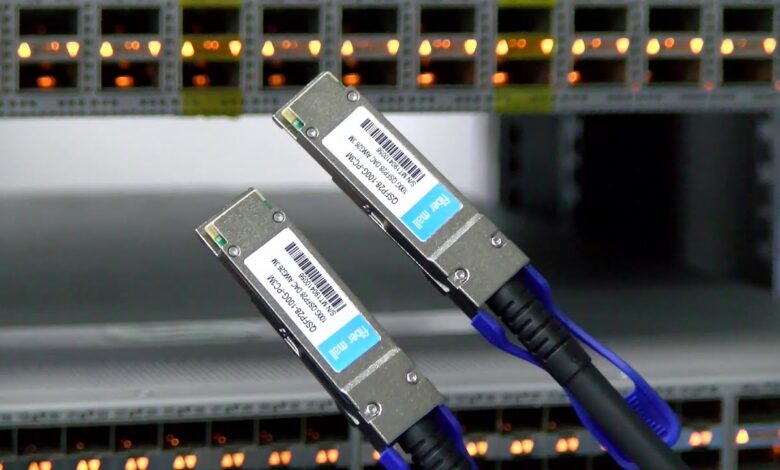25G SFP28 DAC in Data Center Networks: An Efficient and Cost-Effective Short-Distance Interconnect Solution

As data centers continue to expand and require higher bandwidth, efficient, low-latency, and cost-effective interconnect solutions have become a necessity. The transition from 10G to 25G Ethernet has significantly improved network performance while maintaining reasonable costs. Among the various interconnect options, 25G SFP28 Direct Attach Cable (DAC) stands out as a preferred solution for short-distance connections within data centers. This article explores the role of 25G SFP28 DAC in data center networks, its benefits, applications, and potential limitations.
What is 25G SFP28 DAC?
Definition and Basic Structure
A Direct Attach Cable (DAC) is a twinax copper cable with integrated transceivers, designed for short-range data transmission without the need for additional optical components. The 25G SFP28 DAC specifically supports 25Gbps transmission rates over distances of up to 5 meters, making it an ideal solution for intra-rack and inter-rack connections.
Key Technical Specifications
Transmission speed: 25Gbps per channel
Distance: Typically ≤5m
Power consumption: <0.5W per cable
Form factor: SFP28
Plug-and-play capability
Types of 25G DAC
Passive DAC – Best suited for very short distances (up to 3m) with minimal power consumption.
Active DAC – Supports longer distances (3m–5m) and integrates signal conditioning to maintain transmission quality.
Applications of 25G SFP28 DAC in Data Centers
Intra-Rack Server Connectivity (Top of Rack – ToR)
One of the most common applications of 25G DAC is within a single server rack, connecting servers to Top-of-Rack (ToR) switches. Why Use DAC for ToR Connectivity?
Cost-Effective: 25G DAC is significantly cheaper than 25G optical transceivers + fiber cables.
Low Latency: Provides a direct electrical connection, minimizing latency compared to optical transmission.
Energy Efficient: Power consumption is much lower compared to optical modules.
Easy Deployment: Pre-terminated and plug-and-play, reducing installation complexity.
Inter-Rack Network Interconnects (End of Row – EoR / Leaf-Spine Architecture)
In modern Leaf-Spine network architectures, 25G DAC plays a crucial role in connecting Leaf switches to Spine switches over short distances (typically within 1-5m).
Advantages of DAC for Leaf-Spine Connectivity
Improved Cost Efficiency: Reduces total cost compared to optical links, especially for high-density deployments.
High Bandwidth Density: Supports high-port density within data centers, essential for scalable architectures.
Reliability: Provides stable, interference-resistant connections for high-speed data transmission.
Advantages of 25G SFP28 DAC Over Alternative Solutions
Cost-Effective Compared to Optical Solutions
Unlike SFP28 optical modules that require fiber cables, Direct Attach Cable integrates transceivers within the cable, eliminating additional costs. This makes it 30–50% cheaper for short-range connections.
Lower Power Consumption
DAC consumes less than 0.5W per cable, whereas optical modules typically require 1-2W per module. Over hundreds of connections, this translates into significant power savings, reducing cooling requirements in data centers.
Superior Performance for Short Distances
For connections within 5m, DAC offers lower latency and higher reliability compared to fiber optics, making it ideal for high-speed data transmission.
Simplified Deployment and Maintenance
Plug-and-play: No need for transceiver pairing or additional configuration.
Fewer compatibility issues: Unlike some optical modules, DAC is directly compatible with SFP28 ports.
Potential Limitations of 25G SFP28 DAC
Limited Transmission Distance
The maximum range of 25G DAC is 5m, making it unsuitable for medium-to-long-distance connections. For distances beyond this, 25G AOC (Active Optical Cable) or optical transceivers with fiber are required.
Bulkier and Less Flexible than Fiber
DAC cables are thicker and less flexible compared to fiber optic cables, making cable management more challenging in dense network environments.
Compatibility Considerations
Although widely supported, DAC may require specific firmware on certain switches to ensure compatibility. Some vendors lock their devices to proprietary cables, limiting interoperability.
The Future of 25G DAC in Data Centers
As 25G Ethernet adoption grows, 25G DAC will remain a key solution for short-distance interconnects. However, as data centers move towards 50G, 100G, and even 400G architectures, DAC will need to evolve with higher-speed variants such as 50G SFP56 DAC and 100G QSFP28 DAC.
For now, 25G SFP28 DAC is an optimal solution for data centers seeking cost-effective, energy-efficient, and high-performance short-range connectivity.
Conclusion
The demand for high-speed, low-cost, and low-power interconnect solutions in data centers continues to rise. 25G SFP28 DAC offers a perfect balance of affordability, performance, and efficiency for short-range server and switch connections. While it has some limitations in distance and flexibility, its advantages make it a go-to solution for ToR and Leaf-Spine architectures. As data center technologies advance, 25G DAC will continue to play a crucial role in next-generation networking environments.




